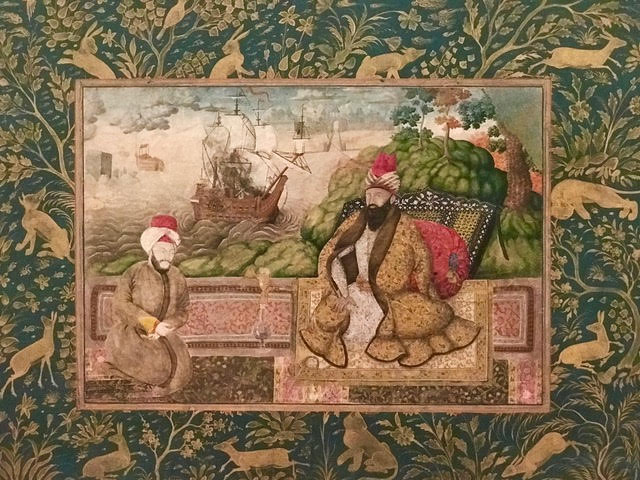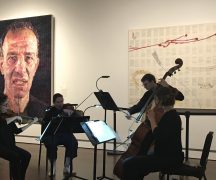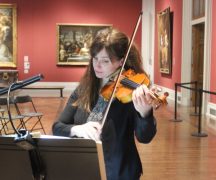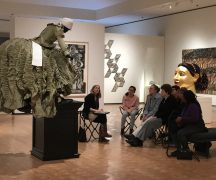By DAVID DUPONT
BG Independent News
For Negar Cooper, the new exhibit at the Toledo Museum of Art, “Bestowing Beauty: Masterpieces from Persian Lands” is personal.
She grew up in Iran, then lived in Italy, until marriage and family brought her to Toledo in 2010.
Now, artistic treasures from her homeland are on the walls of “her” museum in her new hometown. “This made me feel so proud,” she said. “Seeing this art on these walls really made me want to cry.”
A singer and lover of art, she even lends her voice to the audio tour of the exhibition, one of the local residents of Iranian descent with whom the museum consulted.

“Bestowing Beauty: Masterpieces from Persian Lands” opened Saturday (April 23) at the Toledo Museum of Art and will continue in the Levis Gallery through July 17.
Organized by the Museum of Fine Arts, Houston, “Bestowing Beauty” features 100 objects from the collection of Hossein Afshar, one of the most significant collections of Persian art held in private hands. The work, which includes pottery, metalwork, intricately illustrated manuscripts of the Qur’an and Persian epics, paintings, and carpets, spans 1300 years from the 6thcentury just before the arrival of Islam in Persia to the late 19thcentury.
Diane Wright, who with Sophie Ong organized the exhibit in Toledo, at Friday’s preview described the works as “beautiful and incredibly well-crafted that can be enjoyed and appreciated for their aesthetic and formal qualities and merits alone,”

She added: “But these objects were made by people men and women from Persian lands who have rich and meaningful histories that are told by and through the objects you’ll see throughout the galleries. Such artworks can both inspire and educate giving us a broader framework for appreciating not only the similarities, but also the differences between cultures and people from places both far and near.”
It is fitting that this show comes to this region which has one of the largest Muslim populations in the country, she said.
“Bestowing Beauty” is a further chapter in the museum’s mission to demonstrate “a commitment to equality and authentic culture of belonging,” said Adam Levine, the museum’s director.
On Saturday, in his introduction to a concert by acclaimed Persian singer Sara Naeini, Levine noted that the performance was taking place in the museum’s Great Gallery. Lining its walls are masterpieces of Western European art from the Baroque Era.

Now in the nearby Levis Gallery, viewers can see and appreciate the masterpieces of a parallel civilization, a culture as rich and diverse as the one traditionally celebrated in the museum.
The concert offers a jubilant opening for the exhibition. Sung in Persian, Naeini’s music is an ecstatic blend of Persian sounds with pop and jazz. When she asked who in the audience was Persian, hands throughout the packed gallery went up. And members of the audience sang along at several times.
Cooper, who is Naeini’s cousin, facilitated her appearance in Toledo.
After the concert, the audience flowed into the Levis Gallery to view the show.
“Dancing Girl,” an almost life-size portrait of an entertainer from the 18th century by Muhammed Baqir, was a popular stop inside the gallery. Women posed next to the portrait to have their own photos taken.
Cooper had high praise for the Toledo Museum staff’s installation of the show. “They did such a beautiful job,” she said.
Many of the objects are very rare, Cooper said. Given the restrictions in the Islamic Republic of Iran now, some of this work could not be shown in Iran.
That’s the case with another portrait of a female, a wine server whose breasts are visible through the sheer fabric of her garment.
In her comments on the audio tour Cooper spoke of her pride in seeing this depiction of Persian female beauty.
Though Persia is now identified with the modern nation of Iran, the Persian Empire once extended from Cairo to Delhi, and being astride trade routes, reflected the global influences.
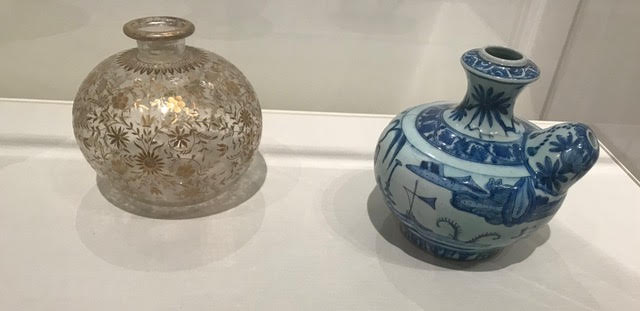
One object in particular, a hookah pipe, encapsulated the global of economy of the time.
The hookah base was used to smoke tobacco from the Americas and originally cultivated by indigenous people. It was farmed on plantations by enslaved Africans. This particular mid-17th century piece is decorated with fanciful landscapes, influenced by the designs of the fine ceramics imported to Persia from China.
The hookah base is displayed in the first of the exhibits five sections: Banquets and Battles; Faith and Piety; Art of the Word; Love and Longing; Authority and Kingship; and Earth and Nature.
These are organizing principles, not strict demarcations.
Each section flows into the others, and little is separated from religious faith. Images of fish and ducks decorate the bottom of a metal bowl from for washing hands at a banquet. The painting of the wine server is rightfully with the images of Love and Longing, though she would be in place as well at a banquet. The carpets and other decorative arts define the spaces of Persian culture.
Much of the calligraphers’ talents were expended on writing out passages from the Qur’an. They created new, elaborate scripts for the task. And they told the stories of their people – the stories of love, battles, and the pre-Islamic myths. Those tales were illustrated by finely wrought miniature paintings. The callgraphers’ art runs through the collection – poetic passages are replicated on the walls above the art.
Wright said that as comprehensive as the collection Afshar collection is, they noticed that it had no examples of Persian glass.
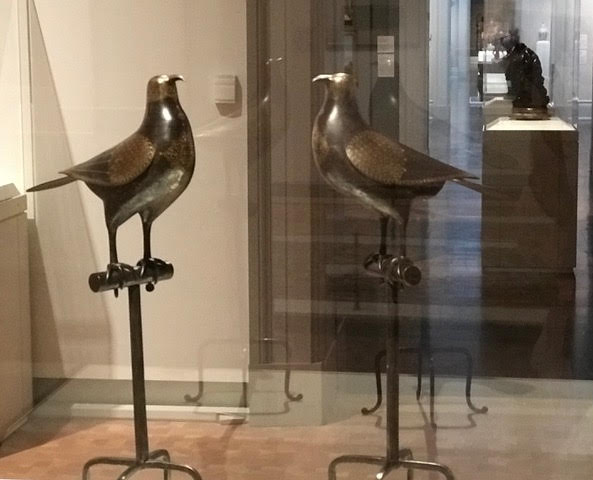
So, the Toledo Museum displayed, with the blessing of the curator in Houston, five objects from its extensive holdings in historic glass. In addition, they hung a contemporary work, “Aram” by Monir Shahroudy Farmanfarmaian. The mirrored glass sculpture from 2015 has a place of pride in the activity area. The piece is constructed so it can be taken apart and fit back together to form 12 different designs. Puzzle pieces on the table allow visitors to engage with “Aram” by replicating that process,.
Most importantly, “Aram” testifies to the enduring nature of the Persian aesthetic ideals that are so well celebrated in “Bestowing Beauty.”

